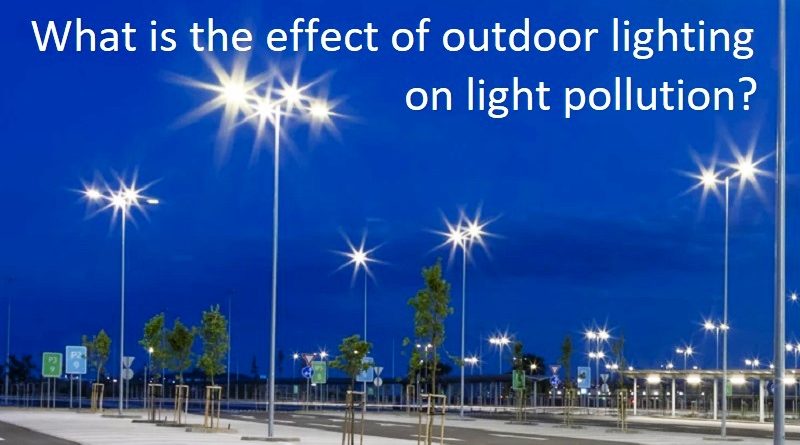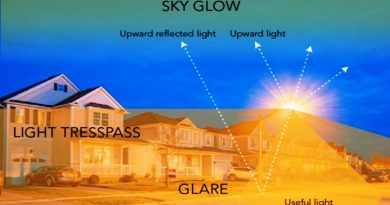What is the effect of outdoor lighting on light pollution?
Light pollution is the excessive and intrusive use of artificial lighting, which disrupts the natural balance of light and darkness in the environment. This phenomenon is caused by a variety of factors, including streetlights, billboards, sports facilities, and other outdoor lighting sources. The purpose of this essay is to explore the effect of outdoor lighting on light pollution in detail.
The first and foremost effect of outdoor lighting on light pollution is its impact on the natural environment. The overuse of outdoor lighting can alter the natural behavior and circadian rhythms of wildlife, including birds, insects, and nocturnal animals. For example, many bird species rely on the natural cycles of light and darkness to regulate their behavior, including migration and breeding. When artificial lighting is introduced into their environment, it can disrupt their natural rhythms, causing them to become disoriented and lose their sense of direction.
Similarly, insects are also affected by outdoor lighting, which can disrupt their ability to navigate and mate. Many nocturnal insects, such as moths and fireflies, are attracted to artificial light, which can confuse them and cause them to become trapped in areas where they are exposed to predators. In some cases, the overuse of outdoor lighting can also have a negative impact on human health, as it can disrupt sleep patterns and cause fatigue and other related health problems.
Another major effect of outdoor lighting on light pollution is its impact on energy consumption and greenhouse gas emissions. The use of outdoor lighting, particularly in urban areas, can account for a significant portion of energy consumption and carbon emissions. This is because outdoor lighting often uses inefficient light sources, such as incandescent bulbs, which consume a significant amount of energy and produce large amounts of heat.
To address this issue, many municipalities and organizations are now implementing more sustainable lighting practices, such as the use of LED lighting, which is significantly more energy-efficient and environmentally friendly than traditional lighting sources. Additionally, many cities and towns are also implementing dark-sky policies, which aim to reduce the amount of light pollution in urban areas and protect the natural environment.
One of the most significant effects of outdoor lighting on light pollution is its impact on astronomy and the study of the night sky. Light pollution can make it difficult for astronomers to observe the stars and other celestial bodies, as it can create a significant amount of glare and reduce the contrast of the night sky. This can make it difficult to see faint objects and can limit the effectiveness of telescopes and other observational instruments.
To address this issue, many observatories and astronomical organizations are now implementing measures to reduce light pollution, such as the use of light shields, which can block out unwanted light sources and improve the visibility of the night sky. Additionally, many organizations are also working to raise public awareness about the issue of light pollution and promote the importance of preserving the night sky for future generations.
In addition to the effects discussed above, outdoor lighting can also have a significant impact on human health and safety. The overuse of outdoor lighting can disrupt sleep patterns, causing fatigue and other related health problems. Additionally, bright outdoor lighting can create glare, which can reduce visibility and increase the risk of accidents and injuries, particularly in areas such as highways and airports.
To address these issues, many cities and municipalities are now implementing more intelligent lighting systems, which can adjust lighting levels based on real-time conditions, such as traffic levels, weather conditions, and pedestrian activity. This can help reduce energy consumption and improve safety and visibility, while also reducing the negative impacts of outdoor lighting on human health and the environment.
Furthermore, outdoor lighting can also have a significant impact on the aesthetics of urban and natural environments. The overuse of bright and intrusive outdoor lighting can detract from the natural beauty of landscapes and can make urban environments feel sterile and uninviting. In contrast, well-designed and carefully placed outdoor lighting can enhance the beauty of natural and urban environments, creating a sense of warmth and intimacy and encouraging people to spend more time outside.
To achieve this balance, many architects, urban planners, and landscape designers are now incorporating lighting design principles into their projects, including the use of layered lighting, which combines different types of lighting to create a more dynamic and visually engaging environment, and the use of directional lighting, which can create subtle and nuanced effects and reduce the negative impacts of outdoor lighting on the environment.
Overall, the effect of outdoor lighting on light pollution is complex and multifaceted, impacting everything from the natural environment and energy consumption to human health, safety, and aesthetics. While there is still much work to be done to address the challenges associated with reducing light pollution, there is also significant progress being made in this area, driven by the efforts of individuals, communities, and organizations around the world. Ultimately, it is up to all of us to work together to find solutions that will help reduce light pollution and protect the natural environment for future generations.
In conclusion, outdoor lighting has a significant impact on light pollution, affecting the natural environment, energy consumption, and greenhouse gas emissions, as well as astronomy and the study of the night sky. While there are many challenges associated with reducing light pollution, including the need for more sustainable lighting practices and the implementation of dark-sky policies, there is also significant progress being made in this area. Ultimately, it is up to individuals, communities, and organizations to work together to find solutions that will help reduce light pollution and protect the natural environment for future generations.





